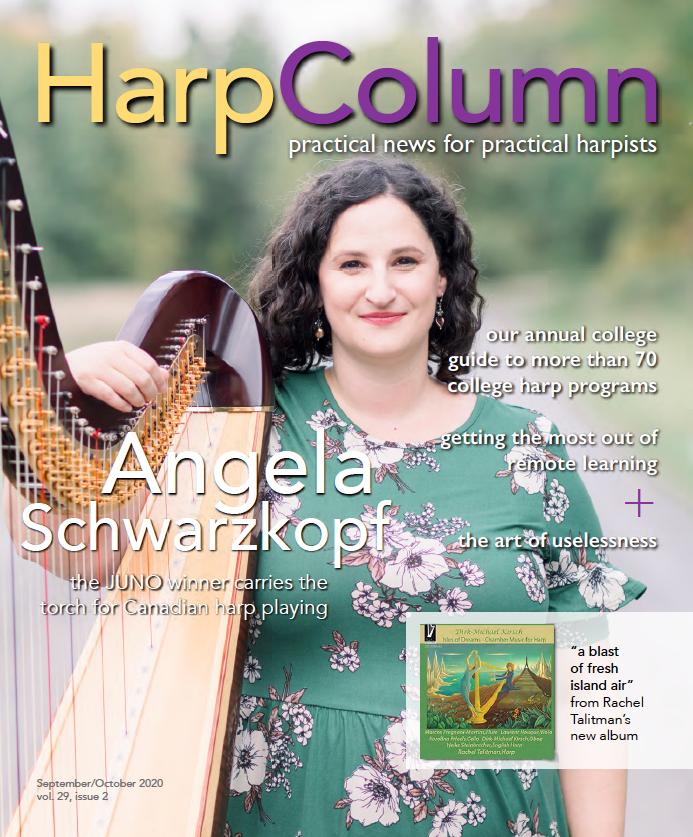My college student arrived at her lesson with a smile on her face, ready to learn. We chatted a bit about her week. She is a nursing major studying harp as a non-major and this was a particularly challenging time. She set her music up, played a bit, and I stopped her. “A lot of harpists struggle with this fingering pattern. Let me demonstrate measure ten for you,” I said as I awkwardly jimmied my music stand around the harp while trying not to drop the iPad on my foot and dump music on the floor.
“Instead of passively letting learning happen, active learning entails naming tasks, information, and goals out loud; honing focus; and engaging more awareness of and participation in what we are doing during our work sessions.”
I’ve taught harp online periodically since 2015. When COVID-19 hit, all of my college and private teaching, faculty meetings, and musical society meetings went digital as well. I miss seeing my students in person, but I feel extremely grateful for the opportunity to stay connected and teach online.
As time went by during the spring and summer, I noticed some positive trends in my instruction—some things became easier and more fluent. It was counterintuitive that any part of teaching would become easier through screens. But upon reflection, I realized I was using active learning concepts similar to those I apply in my practicing.
Instead of passively letting learning happen, active learning entails naming tasks, information, and goals out loud; honing focus; and engaging more awareness of and participation in what we are doing during our work sessions. In my online lessons, I was actively teaching. Could this help me become a better teacher offline as well? I discovered four ways this accidentally-discovered active teaching can improve my lessons when my students and I finally get back into the same room.
The task at hand
I focus more on specific tasks during online lessons. Before I teach, I reflect briefly on points from the student’s last lesson, like fingerings or technical challenges in specific measures, and I also glance at my copy of their music. In doing so, I make a mental checklist of what we need to cover that day. This focused task list allows me to easily jump into our work, improves the consistency of my instruction, and helps me use lesson time more efficiently. Older students write lesson notes in their books. For younger or new students, I write notes in email form. In person, I write most notes in lesson books. There’s no forgetting anything after writing it down!
Words matter
For me, time feels more concentrated when teaching online. In offline instruction, I have the luxury of modifying hand position or a student’s posture and can be rather loquacious in the process. But remote teaching has forced me to speak slower and in more concise detail. Watching myself demonstrate technique in the little thumbnail picture at the bottom of the screen, playing a passage, or holding up the music to explain fingering notation encourages me to both demonstrate and explain musical and technical concepts more slowly and clearly. This helps both me and my students stay focused and on track.
Careful questions & careful listening
At the start of each lesson, I ask students if they have questions from their work the previous week, and often, even younger students respond with things they’ve been wondering about that week (although I always tell my students they can email me with questions). I also ask more questions within the lesson. I find that this teaches them how to reflect upon and analyze the material, while pinpointing problem areas in which to ask for help. This careful questioning started out of necessity—I didn’t want to lose anything in translation through technology—but this is definitely a change that will serve my in-person lessons well too. I’ve been listening to students and their needs more carefully during online teaching. (Again, perhaps because of the quirks of technology?) We often assume we are listening just because we are two feet away from a student, when, in fact, careful listening can only happen if we’re purposeful about it.
Sum it up!
It’s important to end each lesson by offering a three or four count summary of the most important concepts covered. Before online teaching, I tried to remember to do this, but often would forget or run out of time. This summary makes the next lesson easier to begin, and helps both my student and me retain information while clarifying the most important points. I may even ask them to summarize these concepts aloud.
More careful and active online teaching has helped me grow as a teacher in ways I hope to carry forward when we finally have the privilege of working in person again.
Four weeks ago I started working with a new online harp student. Finn is 8 years old. We chatted for a few minutes, then I said, “Let’s learn how to sit at the harp!” After a moment of finding a natural position, the veil of technology disappeared, the distance disappeared, and the awkwardness disappeared. It was just Finn and me discovering the harp, together. •







